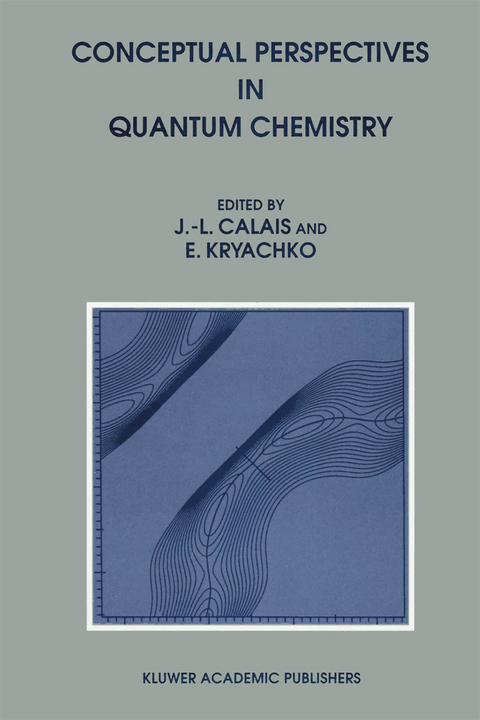
Conceptual Perspectives in Quantum Chemistry
Springer (Verlag)
978-94-010-6348-7 (ISBN)
The rivers run into the sea, yet the sea is not full Ecclesiastes What is quantum chemistry? The straightforward answer is that it is what quan tum chemists do. But it must be admitted, that in contrast to physicists and chemists, "quantum chemists" seem to be a rather ill-defined category of scientists. Quantum chemists are more or less physicists (basically theoreticians), more or less chemists, and by large, computationists. But first and foremost, we, quantum chemists; are conscious beings. We may safely guess that quantum chemistry was one of the first areas in the natural sciences to lie on the boundaries of many disciplines. We may certainly claim that quantum chemists were the first to use computers for really large scale calculations. The scope of the problems which quantum chemistry wishes to answer and which, by its unique nature, only quantum chemistry can answer is growing daily. Retrospectively we may guess that many of those problems meet a daily need, or are say, technical in some sense. The rest are fundamental or conceptual. The daily life of most quantum chemists is usually filled with grasping the more or less technical problems. But it is at least as important to devote some time to the other kind of problems whose solution will open up new perspectives for both quantum chemistry itself and for the natural sciences in general.
Recent Developments In Multiple Scattering Theory And Density Functional Theory For Molecules And Solids.- 1. Introduction.- 2. Multiple Scattering Theory.- 3. Variational Principles.- 4. Wave Functions at Cell Boundaries.- 5. Green Functions.- 6. Computational Theory.- 7. Density Functional Theory.- Acknowledgments.- References.- Localized Atomic Hybrids: A General Theory.- 1. Introduction.- 2. Use of Symmetry.- 3. Basis Space.- 4. Sample Space.- 5. Alias Functions.- 6. Example of Hybrids.- 7. Localization.- 8. Several Equivalent Sets.- 9. Quadrature.- 10.Calculation of Molecular Properties.- References.- Quantum Electrodynamics And Molecular Structure Molecular Electrodynamics.- 1. Introduction.- 2. Quantum Mechanics of the Spectroscopic Experiment.- 3. The Electrodynamics of Molecules.- 4. Electron-Molecule Scattering.- 5. Photon-Molecule Scattering; the Kramers-Heisenberg Formula.- 6. Discussion.- 7. References.- Aspects Of The Chemical Bond 1996.- 1. Introduction.- 2. Ionic Materials.- 3. Application of an Alternative Approach to Inorganic Structures.- 4. Mechanisms of Reactions.- 5. Conclusion.- References.- Lie Symmetries In Quantum Mechanics.- 1. Introduction.- 2. Lie Symmetries.- 3. Solutions to the Time-Dependent Schrödinger Equation.- 4. Coherent States.- 5. Examples.- 6. Transformation of the Schrödinger Equation.- Acknowledgement.- Appendix I.- References.- The Interplay Between Quantum Chemistry And Molecular Dynamics Simulations.- 1. Introduction.- 2. Molecular Dynamics Simulations.- 3. Aspects of Parametrization.- 4. Conclusions.- 5. Acknowledgements.- 6. References.- The Permutation Group In Many-Electron Theory.- 1. Introduction.- 2. The Electronic Schrödinger Equation.- 3. Approximate N-Electron Functions.- 4. Concluding Remarks.- 5.Acknowledgment.- References.- New Developments In Many Body Perturbation Theory And Coupled Cluster Theory.- 1. Introduction.- 2. Møller-Plesset Perturbation Theory.- 3. Møller-Plesset Perturbation Theory at Sixth Order.- 4. Coupled Cluster Theory.- 5. Analysis of Coupled Cluster Methods in Terms of Perturbation Theory.- 6. Coupled Cluster Methods with Triple Excitations.- 7. Conclusions and Outlook.- 8. Acknowledgements.- 9. References.- A Philosopher’s Perspective On The “Problem” Of Molecular Shape.- 1. Introduction.- 2. A Physical Account of Shape.- 3. Interlude: Exactly Which Concept of Shape is Being Challenged?.- 4. Reduction and Explanation.- 5. Realism, Physicalism and Materialism.- 6. Conclusion.- Acknowledgements.- Endnotes.- References.- Van Der Waals Interactions From Density Functional Theories: The He-CO System As A Case Study.- 1. Introduction.- 2. An Outline of Interaction Contributions.- 3. The Density Functional Approach.- 4. An Overview of Earlier Studies on the He-CO Interaction.- 5. DFT Calculations of the Interaction.- 6. Summary and Conclusions.- 7. Acknowledgements.- References.- Different Legacies and Common Aims: Robert Mulliken, Linus Pauling And The Origins Of Quantum Chemistry.- I.- II.- Notes.- Potential Energy Hypersurfaces For Hydrogen Bonded Clusters (HF) N.- 1. Introduction.- 2. Sampling and Representation Methodology.- 3. Approximations in ab Initio Electronic Structure Theory.- 4. Potentials.- 5. Clusters.- 6. Conclusions and Outlook.- Acknowledgement.- References.- One-Electron Pictures Of Electronic Structure: Propagator Calculations On Photoelectron Spectra Of Aromatic Molecules.- 1. Introduction.- 2. The Electron Propagator.- 3. The Uncorrelated Case.- 4. Superoperator Theory.- 5. Projection and Partitioning Techniques.-6. Relationships to Hilbert Space Theories.- 7. The Dyson Equation.- 8. Perturbative Self-Energies.- 9. Quasiparticle Methods.- 10.Computational Techniques.- 11.Interpretations of Photoelectron Spectra.- 12.Conclusions.- 13.Acknowledgments.- References.- Shape in Quantum Chemistry.- 1. Introduction.- 2. Molecular Shape: The Shape Group Methods.- 3. The Shape of Potential Energy Hypersurfaces: The Fundamental Group of Reaction Mechanisms.- 4. An Analogy Between Shape Groups and The Fundamental Groups of Reaction Mechanisms.- Summary.- References.
| Zusatzinfo | XVI, 553 p. |
|---|---|
| Verlagsort | Dordrecht |
| Sprache | englisch |
| Maße | 160 x 240 mm |
| Themenwelt | Naturwissenschaften ► Chemie ► Physikalische Chemie |
| Naturwissenschaften ► Physik / Astronomie ► Quantenphysik | |
| ISBN-10 | 94-010-6348-6 / 9401063486 |
| ISBN-13 | 978-94-010-6348-7 / 9789401063487 |
| Zustand | Neuware |
| Haben Sie eine Frage zum Produkt? |
aus dem Bereich


